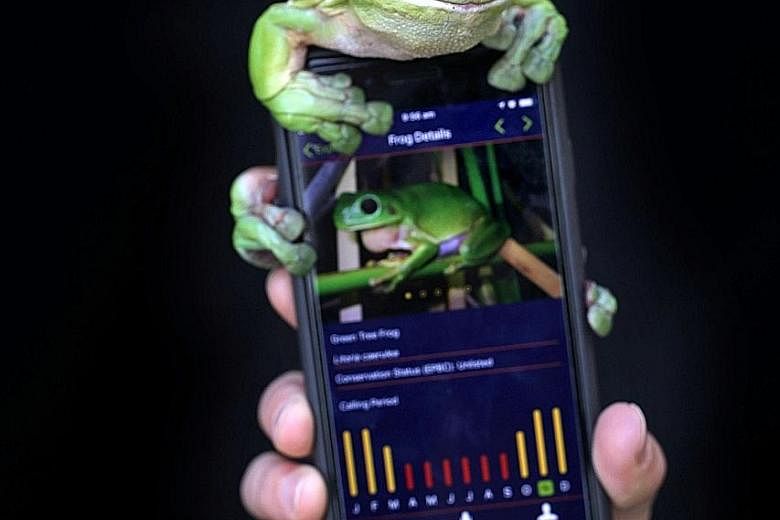At swamps and ponds across Australia - or anywhere one might hear a croak or a ribbit - thousands of Australians have been quickly reaching for their phones to record calls from one of the world's most threatened types of animal: frogs.
Using a specially designed smartphone app, the recordings are submitted to scientists who can identify the frog and use the information to track the species' population and whereabouts.
The FrogID app project, run by the Australian Museum in Sydney, has captured the calls of 14,500 individual frogs around the nation since November, and transformed thousands of Australians into amateur biologists. The app, developed in partnership with IBM, has been downloaded 33,000 times and there have been 12,500 recordings submitted, which can sometimes contain the calls of numerous species of frog.
It is one of several projects which are involving the public in a quest to find and protect native species in a country that has one of the world's worst records for species loss.
Dr Jodi Rowley, the museum's curator of amphibian and reptile conservation biology, said frogs are easily identifiable by their call, which is used by the male to attract mates and is unique to each species. She said it was easier for people to record and send audio of the calls on their phones than to try to photograph the frogs, which can be evasive and difficult to find.
"Frogs are really hard to identify from their appearance - it is often easier with calls," she told The Straits Times.
"There is an insane diversity of frog sounds, from honks to barks to croaks and whistles. This is crowdsourcing the information we need for conservation."

Around the world, the number of frog species has been declining due to factors such as climate change, deforestation, pollution and urban development.
Australia has 240 known frog species, including five that are critically endangered, 14 that are endangered and 10 that are vulnerable. Another four have become extinct.
The FrogID app captures the location and time of the call, which will assist scientists to identify species and record information about their habitat. Eventually, this will allow scientists to examine how their numbers, breeding patterns and habitats are changing and to develop plans to protect and save them.
Dr Rowley said the information had helped to show that specific frogs exist in previously unknown locations or that the range of their habitats in some areas extends some 100km further than thought. She said sounds have been captured from highly remote areas, which are difficult to reach and would require vast amounts of luck or time for a biologist to happen to be there when a frog was calling.
"This allows us to have a whole army of frog biologists that can get out and are there on time and can help us to understand frogs around Australia," she said.
"The information is on a scale that we could never have dreamed of."
Australia is a vast land mass, long separated from other continents, and most of its species are not found anywhere else.
Citizen science projects are proving crucial in discovering more about the nation's often largely unknown native flora and fauna.
Recently, a conservation app was used to discover seven previously undescribed species of spider.
The app, QuestaGame, encourages users to submit photographs of rare and unknown species, as well as field notes.
During an "Arachnid Adventure" competition from Dec 8 to 24, users were invited to submit spider photos. This resulted in 1,910 images of spiders being identified across 146 species.
The seven new species have yet to be scientifically named but were given informal names, such as "exclamation mark spider" for a creature with a white line along its back trailed by a dot.
Spider expert Robert Whyte, an honorary researcher at the Queensland Museum, which worked with QuestaGame on the project, said Australia has 4,000 known spiders but many more have yet to be discovered or described. He said the citizen science data was helping to identify spider habitats and could potentially help to research venoms that could be used for medical purposes or to better understand the biological qualities of the creatures.
"We want to know where the spiders are, how they got there and what they do in the ecology, so that we can draw inferences on how they respond to change," he told The Straits Times.
"We want to know what is going on in this continent, which has so many instances of adaptation."
Mr Whyte said some of the new spider species could potentially be named after their discoverers.
Likewise, Dr Rowley said some of the publicly collected frog sounds could be used in scientific publications.
She said she hoped the recordings could be used to build a massive database of frog calls, allowing for real-time identification of species.
"Ultimately, we want a frog Shazam," she said, referring to the popular music-identification app.


